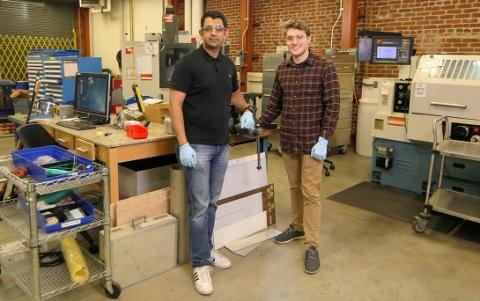
Since the 1940s, the responsibility for managing California farmers' use of agricultural pesticides, and the substantial health risks they pose, has been shared by state and county regulators. The state's Department of Pesticide Regulation registers pesticide products; county-level agricultural commissioners issue permits for the use of "restricted" pesticides — those that present significant human health or environmental concerns.

UCLA alumni Ralph and Shirley Shapiro received the UCLA Medal, the campus’ highest honor, on April 2, at the Chancellor’s residence.
“When we talk about service as a core mission of UCLA — alongside research and education — two of the names that always come to my mind are Ralph and Shirley Shapiro,” UCLA Chancellor Gene Block said at the medal ceremony. “They met at UCLA, formed a beautiful partnership here and have both made UCLA very proud. My hope is that UCLA will continue to graduate students who share their values and will extend their legacy.”

The future looked bright — and clean and efficient — when a team of law students took home the top prize in UCLA School of Law’s Lowell Milken Institute-Sandler Prize for New Entrepreneurs one year ago. Class of 2018 members Mac Kennedy and Mary Vu won $70,000 in seed funding for their company Mote, which is developing a device that filters toxic particles from car tailpipes. They worked with engineers from Caltech and the Lawrence Livermore National Laboratory to develop the winning entry.

As the dangers of climate change grow and global political tensions rise, UCLA, in partnership with the University of California, Berkeley and other UC campuses, former California Governor Edmund G. Brown Jr. and China's top climate change official Xie Zhenhua, today launched a groundbreaking new initiative — the California-China Climate Institute — to spur further climate action through joint research, training and dialogue.
On August 24, 2020, UCLA Law faculty members Sean B. Hecht and Charles R. Corbett filed an amicus brief for the Frank G. Wells Environmental Law Clinic in a case before the U.S. Ninth Circuit Court of Appeals (Case No. 20-71196) concerning the regulation of air pollution in Imperial Valley, California. The brief was filed on behalf of Comité Civico del Valle, an environmental justice and public health organization that advocates for better pollution controls in Imperial County.
On July 31, 2020, UCLA Law faculty members Adrien Abecassis, Charles R. Corbett, Benjamin Harris, Edward A. Parson, and Jesse L. Reynolds submitted a comment letter to an independent advisory committee for a proposed Harvard solar geoengineering experiment. The comment letter praises the experiment’s governance framework as a whole and suggests ideas for creating a meaningful, appropriate public engagement process.
全球范围内的城市、省份及国家在减少污染方面都面临着显著的挑战,这些污染损害了当地的空气质量的同时也进一步加剧了气候变化。近年来,多个地区已经开始对污染物进行协同治理。这些地区以“一石二鸟”的原则制定政策,以期同时达到气候变化及空气质量方面的目标。
加州是最早对空气污染与气候变化进行协同治理的地区之一,目前已经在多污染物规划方面积累了丰富的经验。本报告侧重加州经验,对空气与气候的协同治理进行了研究。为探究在中国进行空气与气候协同治理的可能性,我们与中国伙伴合作开展了此次研究。在煤炭用量占总能源比例更高的中国,协同治理将能在传统空气污染物和温室气体排放方面带来更大的协同效益。尽管本报告主要是为中国的政策制定者提供的,它也对来自其他任何地区希望提升协同治理的管理者和学者有所帮助。
本报告的作者是:加州大学洛杉矶分校法学院,教授Alex Wang;自然资源保护协会,高级律师David Pettit;加州大学洛杉矶分校法学院 Emmett/Frankel环境法律与政策研究员Siyi Shen。
Cities, states, and countries around the world face a significant challenge in limiting pollution that harms local air quality and contributes to climate change. In recent years, some jurisdictions have begun to engage in coordinated governance of pollutants, planning policies that “kill two birds with one stone” to achieve climate and air quality goals at the same time.
On behalf of 29 U.S. Senators and 118 U.S. Representatives, the Frank G. Wells Environmental Law Clinic filed an amicus brief on July 6, 2020, in a D.C. Circuit case challenging the Trump administration's attempt to revoke California's clean car standards.